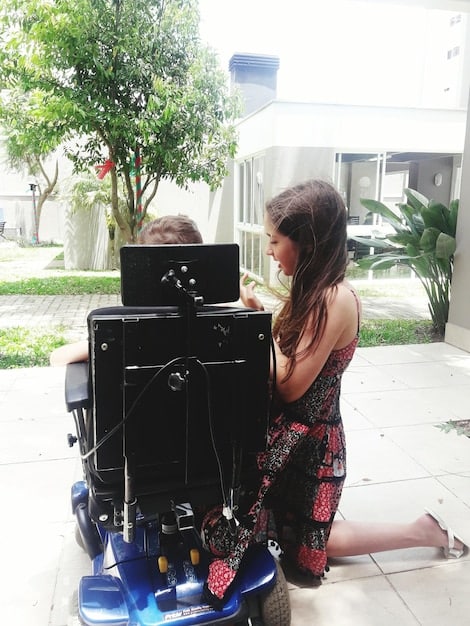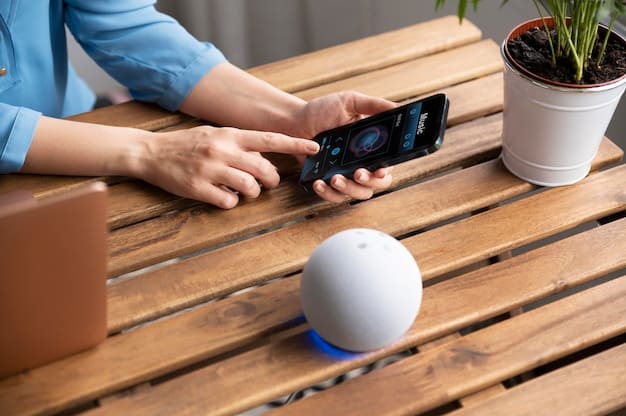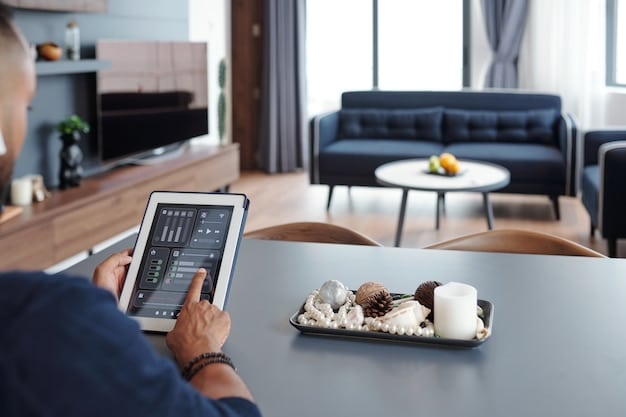Smart Home Accessibility: Voice Control & Automation for Disabilities

Smart Home Accessibility: How Voice Control and Automation Are Empowering People with Disabilities, through the integration of voice assistants, automated systems, and smart devices, are improving independence and quality of life for individuals with disabilities by streamlining daily tasks and enhancing overall safety and convenience.
The convergence of smart home technology and assistive solutions marks a transformative era for people with disabilities. Smart Home Accessibility: How Voice Control and Automation Are Empowering People with Disabilities isn’t just a trend; it’s a fundamental shift towards creating more inclusive and accessible living environments. By harnessing the power of voice commands, automated systems, and interconnected devices, individuals can gain greater control over their surroundings, fostering independence and enhancing their overall quality of life.
Understanding the Landscape of Smart Home Accessibility
Smart home accessibility is a rapidly evolving field that focuses on adapting mainstream smart home technologies to meet the unique needs of people with disabilities. It goes beyond simple convenience, addressing critical aspects of daily living such as safety, communication, and environmental control. Understanding the basics and the potential impact of these technologies is crucial for anyone looking to make their home more accessible.
What is Smart Home Technology?
Smart home technology encompasses a wide range of devices and systems designed to automate tasks and enhance convenience through connectivity. These devices can include smart lighting, thermostats, security systems, and appliances, all controlled remotely via smartphone apps or voice commands.
The Importance of Accessibility
For individuals with disabilities, accessible smart home technology can be life-changing. It can reduce reliance on caregivers, promote independence, and provide a greater sense of control over their environment. By automating tasks that might otherwise be difficult or impossible, it opens up new possibilities and improves overall well-being.

Integrating these technologies thoughtfully can significantly enhance the living experience, fostering a more inclusive and supportive home environment.
- Enhanced Independence: Smart home devices allow individuals to manage their environment without physical assistance, promoting autonomy.
- Increased Safety: Systems like smart smoke detectors and security cameras can provide crucial alerts and support for those with sensory or mobility impairments.
- Improved Communication: Voice-activated communication systems and smart displays can facilitate easier and more reliable communication with family, friends, and caregivers.
Ultimately, smart home accessibility is about creating a personalized environment that adapts to the individual’s needs, promoting a more comfortable, safe, and independent lifestyle.
Voice Control: A Gateway to Independence
Voice control has emerged as a pivotal technology in smart home accessibility, offering a hands-free and intuitive way for individuals with limited mobility or visual impairments to interact with their environment. Voice assistants like Amazon Alexa, Google Assistant, and Apple’s Siri provide a simple yet powerful interface for controlling various smart home devices.
How Voice Assistants Work
Voice assistants use natural language processing to understand and respond to verbal commands. They can be used to control lighting, adjust thermostats, play music, make phone calls, and even operate appliances, all without the need for physical interaction or dexterity.
Benefits for People with Disabilities
The benefits of voice control for people with disabilities are numerous. For instance, someone with limited mobility can use voice commands to adjust the temperature or turn on lights without struggling to reach switches. Similarly, individuals with visual impairments can rely on voice feedback and spoken prompts to navigate and manage their smart home devices.
Voice commands offer a direct way of engaging with accessible technology, unlocking a new level of independence.
- Hands-Free Operation: Voice control eliminates the need for physical interaction, making it ideal for people with limited mobility.
- Easy Navigation: Voice prompts and feedback provide auditory cues for individuals with visual impairments.
- Customization and Personalization: Voice assistants can be programmed with custom routines and responses to match individual needs and preferences.
Voice control is not just about convenience; it’s about empowering individuals with disabilities to live more independently and safely in their own homes.
Automation: Simplifying Daily Routines
Automation plays a crucial role in smart home accessibility by streamlining daily routines and automating repetitive tasks. By programming devices to respond to specific triggers or schedules, individuals can minimize the need for manual intervention and simplify their daily lives. This can be particularly beneficial for those with cognitive or physical limitations.
Creating Automated Routines
Smart home automation allows users to create personalized routines that automate multiple tasks simultaneously. For example, a “Good Morning” routine could turn on the lights, adjust the thermostat, and play the news with a single voice command. Similarly, a “Good Night” routine could turn off all the lights, lock the doors, and set the alarm with a single instruction.
Benefits for Different Abilities
For individuals with cognitive impairments, automated routines can provide structure and predictability, minimizing confusion and reducing the need for constant decision-making. For those with physical limitations, automation can eliminate the need for strenuous or repetitive tasks, conserving energy and promoting independence. The key lies in understanding how to tailor a smart home to the individual’s needs so that it functions in the most optimized way possible.

Smart home automation represents a significant opportunity to create more supportive and adaptive living environments for people with disabilities.
- Consistency and Predictability: Automated routines provide structure and reduce the cognitive load for individuals with cognitive impairments.
- Energy Conservation: Automation eliminates unnecessary tasks, conserving energy and reducing physical strain.
- Enhanced Safety: Automated security systems and safety alerts provide peace of mind and timely assistance.
By thoughtfully implementing automated routines, it’s possible to create a home environment that supports independence, promotes safety, and enhances overall well-being.
Specific Smart Home Devices for Accessibility
A variety of smart home devices can be leveraged to enhance accessibility. These devices range from simple voice-activated lights to complex environmental control systems. Selecting the right devices and integrating them effectively is crucial for creating a truly accessible smart home and making smart home accessible to those in need.
Smart Lighting Solutions
Smart lighting systems allow users to control the brightness and color of lights via voice commands or smartphone apps. This can be particularly useful for individuals with visual impairments, as they can adjust the lighting to their preferred levels without physical interaction.
Smart Thermostats
Smart thermostats enable users to adjust the temperature of their home remotely. This can be beneficial for individuals with mobility issues who may have difficulty reaching the thermostat. They also allow for energy savings and enable the user to set temperatures at preferred times.
Smart Security Systems
Smart security systems can provide enhanced safety and peace of mind for people with disabilities. These systems often include features such as video doorbells, motion sensors, and smart locks, all of which can be controlled remotely. Smart security systems may also include emergency assistance and notifications ensuring people receive assistance if needed.
Thoughtful integration of these devices can empower individuals with disabilities and enhance their control and agency significantly.
- Voice-Activated Lights: Provide easy control over lighting for individuals with limited mobility or visual impairments.
- Smart Thermostats: Allow remote temperature adjustments, improving comfort and energy efficiency.
- Video Doorbells: Enhance safety by providing a visual and audio interface for answering the door remotely.
Choosing the right smart home devices and integrating them effectively is essential for creating a truly accessible and supportive living environment.
Overcoming Challenges and Ensuring Compatibility
While smart home technology offers tremendous potential for enhancing accessibility, it’s essential to be aware of the challenges and limitations that can arise. Ensuring compatibility between devices, addressing privacy concerns, and prioritizing user-friendly interfaces are critical considerations for successful smart home implementation. Overcoming obstacles will ensure people are able to enjoy smart home capability to its potential.
Addressing Compatibility Issues
Not all smart home devices are compatible with each other. It’s essential to choose devices that use a common communication protocol, such as Zigbee or Z-Wave, to ensure seamless integration. Alternatively, consider using a smart home hub that supports multiple protocols.
Prioritizing User-Friendly Interfaces
Smart home interfaces should be intuitive and easy to use, regardless of the individual’s abilities. Voice control is often the preferred option for those with limited mobility or visual impairments. For others, a simple smartphone app with large, clear icons may be more suitable. Many smart home devices also allow for adjusting the interface to address peoples needs.
Smart homes should be designed to accommodate the users needs and desires for optimum results.
- Research and Planning: Thoroughly research device compatibility and integration options before making a purchase.
- User Testing: Involve individuals with disabilities in the testing and feedback process to ensure user-friendliness and effectiveness.
- Ongoing Support: Provide ongoing training and support to help users learn how to use and maintain their smart home systems effectively.
By carefully addressing these challenges, it’s possible to create smart home environments that are both accessible and user-friendly for people with disabilities.
The Future of Smart Home Accessibility
The future of smart home accessibility is bright, with ongoing technological advancements promising even greater levels of independence and convenience for people with disabilities. As artificial intelligence, machine learning, and sensor technologies continue to evolve, smart homes will become increasingly adaptive and responsive to individual needs.
Advancements in AI and Machine Learning
AI and machine learning are already being used to personalize smart home experiences and automate complex tasks. In the future, these technologies will enable smart homes to learn individual preferences and anticipate needs, providing proactive support and assistance.
The Role of Sensor Technologies
Sensor technologies, such as wearable sensors and environmental sensors, will play an increasingly important role in smart home accessibility. These sensors can monitor vital signs, detect falls, and track activity levels, providing valuable data for caregivers and healthcare providers. They also can ensure help comes when needed most.
These improvements will continue to transform the lives of those with disabilities and revolutionize smart homes.
- Personalized Experiences: AI and machine learning will enable smart homes to adapt to individual needs and preferences in real-time.
- Proactive Support: Smart homes will be able to anticipate needs and provide proactive assistance based on sensor data and learned behaviors.
- Seamless Integration: Advancements in communication protocols and device compatibility will create more seamless and integrated smart home ecosystems.
The future of smart home accessibility is about creating truly adaptive and supportive living environments that empower people with disabilities to live more fulfilling and independent lives and is an exciting frontier.
| Key Point | Brief Description |
|---|---|
| 🗣️ Voice Control | Hands-free operation for lighting, temperature, and more. |
| ⚙️ Automation | Simplifies routines, enhancing consistency and predictability. |
| 💡 Smart Lighting | Adjustable brightness via voice or app for visual needs. |
| 🔒 Smart Security | Enhanced safety with video doorbells and remote monitoring. |
FAQ
▼
Smart home accessibility involves adapting smart home technology to meet the unique needs of people with disabilities, improving their independence and quality of life.
▼
Voice control allows hands-free operation of devices like lights and thermostats, benefiting individuals with limited mobility or visual impairments.
▼
Automated routines are programmed sequences that simplify daily tasks, provide structure for those with cognitive impairments, and conserve energy.
▼
Common devices include smart lighting, thermostats, and security systems, each offering features tailored for different accessibility needs.
▼
Challenges are addressed by ensuring device compatibility, prioritizing user-friendly interfaces, and providing ongoing support and training.
Conclusion
Smart home accessibility represents a transformative opportunity to empower individuals with disabilities. By harnessing the power of voice control, automation, and interconnected devices, it’s possible to create more inclusive and supportive living environments that promote independence, safety, and overall well-being. As technology continues to evolve, the future of smart home accessibility promises even greater levels of personalization and proactive support.





